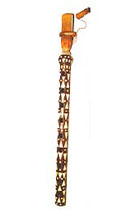|  The
balaban is a wind instrument that is widely used in
orchestras, ensembles, ashug and other folklore groups
(photo 14). The name of the instrument (sometimes
pronounced as "balaman") probably originates
from the words "bala" (small) and "ban"
(cock's cry). The
balaban is a wind instrument that is widely used in
orchestras, ensembles, ashug and other folklore groups
(photo 14). The name of the instrument (sometimes
pronounced as "balaman") probably originates
from the words "bala" (small) and "ban"
(cock's cry).
 The
balaban, which has a soft, melancholic sound, is used
in ensembles, orchestras and as a solo instrument,
as well as to accompany groups of wind instruments
and groups of ashugs. The balaban is usually hewn
out of apricot, walnut, mulberry or pear wood. The
balaban, which has a soft, melancholic sound, is used
in ensembles, orchestras and as a solo instrument,
as well as to accompany groups of wind instruments
and groups of ashugs. The balaban is usually hewn
out of apricot, walnut, mulberry or pear wood.
 |
Wooden
balabans
The State Museum
of Azerbaijani Musical Culture.
Baku |
After that, it is soaked
in vegetable oils and then dried at a particular temperature
for a long time. Eight apertures are cut on the front
side, and one is cut on the back. To play the instrument,
the musician opens and closes the apertures with the
fingers of both hands. A mouthpiece is attached at
the head of the instrument. This mouthpiece is made
of cane of a specific size that is flattened on one
side. Because of this, sometimes the instrument is
called the "yasti balaban" (flat balaban).
With the help of a clamp that is fitted to the mouthpiece,
the musician can regulate the musical tone and pitch
of the sound. To produce a tone, the player, deeply
breathing, directs air into the mouthpiece, which
is placed between the lips. By placing his fingers
over the apertures, he achieves the desired pitch.
The length of the instrument is 280-300 mm, and the
diameter is 20-22 mm. The balaban's range goes from
the "sol" of the small octave to the "do"
of the second octave. The diapason can be expanded,
depending upon the mastery of the performer.
|